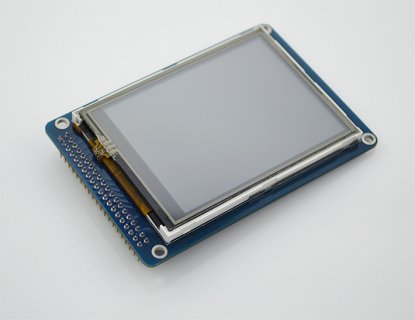// UTFT_Demo_320x240
// Copyright (C)2015 Rinky-Dink Electronics, Henning Karlsen. All right reserved
// web: http://www.RinkyDinkElectronics.com/
//
// This program is a demo of how to use most of the functions
// of the library with a supported display modules.
//
// This demo was made for modules with a screen resolution
// of 320x240 pixels.
//
// This program requires the UTFT library.
//
#include <UTFT.h>
// Declare which fonts we will be using
extern uint8_t SmallFont[];
// Set the pins to the correct ones for your development shield
// ------------------------------------------------------------
// Standard Arduino Mega/Due shield : <display model>,38,39,40,41
// CTE TFT LCD/SD Shield for Arduino Due : <display model>,25,26,27,28
// Teensy 3.x TFT Test Board : <display model>,23,22, 3, 4
// ElecHouse TFT LCD/SD Shield for Arduino Due : <display model>,22,23,31,33
//
// Remember to change the model parameter to suit your display module!
UTFT myGLCD(ILI9327,36,35,34,33);
void setup()
{
randomSeed(analogRead(0));
// Setup the LCD
myGLCD.InitLCD();
myGLCD.setFont(SmallFont);
}
void loop()
{
int buf[318];
int x, x2;
int y, y2;
int r;
// Clear the screen and draw the frame
myGLCD.clrScr();
myGLCD.setColor(255, 0, 0);
myGLCD.fillRect(0, 0, 319, 13);
myGLCD.setColor(64, 64, 64);
myGLCD.fillRect(0, 226, 319, 239);
myGLCD.setColor(255, 255, 255);
myGLCD.setBackColor(255, 0, 0);
myGLCD.print("* Universal Color TFT Display Library *", CENTER, 1);
myGLCD.setBackColor(64, 64, 64);
myGLCD.setColor(255,255,0);
myGLCD.print("<http://www.RinkyDinkElectronics.com/>", CENTER, 227);
myGLCD.setColor(0, 0, 255);
myGLCD.drawRect(0, 14, 319, 225);
// Draw crosshairs
myGLCD.setColor(0, 0, 255);
myGLCD.setBackColor(0, 0, 0);
myGLCD.drawLine(159, 15, 159, 224);
myGLCD.drawLine(1, 119, 318, 119);
for (int i=9; i<310; i+=10)
myGLCD.drawLine(i, 117, i, 121);
for (int i=19; i<220; i+=10)
myGLCD.drawLine(157, i, 161, i);
// Draw sin-, cos- and tan-lines
myGLCD.setColor(0,255,255);
myGLCD.print("Sin", 5, 15);
for (int i=1; i<318; i++)
{
myGLCD.drawPixel(i,119+(sin(((i*1.13)*3.14)/180)*95));
}
myGLCD.setColor(255,0,0);
myGLCD.print("Cos", 5, 27);
for (int i=1; i<318; i++)
{
myGLCD.drawPixel(i,119+(cos(((i*1.13)*3.14)/180)*95));
}
myGLCD.setColor(255,255,0);
myGLCD.print("Tan", 5, 39);
for (int i=1; i<318; i++)
{
myGLCD.drawPixel(i,119+(tan(((i*1.13)*3.14)/180)));
}
delay(2000);
myGLCD.setColor(0,0,0);
myGLCD.fillRect(1,15,318,224);
myGLCD.setColor(0, 0, 255);
myGLCD.setBackColor(0, 0, 0);
myGLCD.drawLine(159, 15, 159, 224);
myGLCD.drawLine(1, 119, 318, 119);
// Draw a moving sinewave
x=1;
for (int i=1; i<(318*20); i++)
{
x++;
if (x==319)
x=1;
if (i>319)
{
if ((x==159)||(buf[x-1]==119))
myGLCD.setColor(0,0,255);
else
myGLCD.setColor(0,0,0);
myGLCD.drawPixel(x,buf[x-1]);
}
myGLCD.setColor(0,255,255);
y=119+(sin(((i*1.1)*3.14)/180)*(90-(i / 100)));
myGLCD.drawPixel(x,y);
buf[x-1]=y;
}
delay(2000);
myGLCD.setColor(0,0,0);
myGLCD.fillRect(1,15,318,224);
// Draw some filled rectangles
for (int i=1; i<6; i++)
{
switch (i)
{
case 1:
myGLCD.setColor(255,0,255);
break;
case 2:
myGLCD.setColor(255,0,0);
break;
case 3:
myGLCD.setColor(0,255,0);
break;
case 4:
myGLCD.setColor(0,0,255);
break;
case 5:
myGLCD.setColor(255,255,0);
break;
}
myGLCD.fillRect(70+(i*20), 30+(i*20), 130+(i*20), 90+(i*20));
}
delay(2000);
myGLCD.setColor(0,0,0);
myGLCD.fillRect(1,15,318,224);
// Draw some filled, rounded rectangles
for (int i=1; i<6; i++)
{
switch (i)
{
case 1:
myGLCD.setColor(255,0,255);
break;
case 2:
myGLCD.setColor(255,0,0);
break;
case 3:
myGLCD.setColor(0,255,0);
break;
case 4:
myGLCD.setColor(0,0,255);
break;
case 5:
myGLCD.setColor(255,255,0);
break;
}
myGLCD.fillRoundRect(190-(i*20), 30+(i*20), 250-(i*20), 90+(i*20));
}
delay(2000);
myGLCD.setColor(0,0,0);
myGLCD.fillRect(1,15,318,224);
// Draw some filled circles
for (int i=1; i<6; i++)
{
switch (i)
{
case 1:
myGLCD.setColor(255,0,255);
break;
case 2:
myGLCD.setColor(255,0,0);
break;
case 3:
myGLCD.setColor(0,255,0);
break;
case 4:
myGLCD.setColor(0,0,255);
break;
case 5:
myGLCD.setColor(255,255,0);
break;
}
myGLCD.fillCircle(100+(i*20),60+(i*20), 30);
}
delay(2000);
myGLCD.setColor(0,0,0);
myGLCD.fillRect(1,15,318,224);
// Draw some lines in a pattern
myGLCD.setColor (255,0,0);
for (int i=15; i<224; i+=5)
{
myGLCD.drawLine(1, i, (i*1.44)-10, 224);
}
myGLCD.setColor (255,0,0);
for (int i=224; i>15; i-=5)
{
myGLCD.drawLine(318, i, (i*1.44)-11, 15);
}
myGLCD.setColor (0,255,255);
for (int i=224; i>15; i-=5)
{
myGLCD.drawLine(1, i, 331-(i*1.44), 15);
}
myGLCD.setColor (0,255,255);
for (int i=15; i<224; i+=5)
{
myGLCD.drawLine(318, i, 330-(i*1.44), 224);
}
delay(2000);
myGLCD.setColor(0,0,0);
myGLCD.fillRect(1,15,318,224);
// Draw some random circles
for (int i=0; i<100; i++)
{
myGLCD.setColor(random(255), random(255), random(255));
x=32+random(256);
y=45+random(146);
r=random(30);
myGLCD.drawCircle(x, y, r);
}
delay(2000);
myGLCD.setColor(0,0,0);
myGLCD.fillRect(1,15,318,224);
// Draw some random rectangles
for (int i=0; i<100; i++)
{
myGLCD.setColor(random(255), random(255), random(255));
x=2+random(316);
y=16+random(207);
x2=2+random(316);
y2=16+random(207);
myGLCD.drawRect(x, y, x2, y2);
}
delay(2000);
myGLCD.setColor(0,0,0);
myGLCD.fillRect(1,15,318,224);
// Draw some random rounded rectangles
for (int i=0; i<100; i++)
{
myGLCD.setColor(random(255), random(255), random(255));
x=2+random(316);
y=16+random(207);
x2=2+random(316);
y2=16+random(207);
myGLCD.drawRoundRect(x, y, x2, y2);
}
delay(2000);
myGLCD.setColor(0,0,0);
myGLCD.fillRect(1,15,318,224);
for (int i=0; i<100; i++)
{
myGLCD.setColor(random(255), random(255), random(255));
x=2+random(316);
y=16+random(209);
x2=2+random(316);
y2=16+random(209);
myGLCD.drawLine(x, y, x2, y2);
}
delay(2000);
myGLCD.setColor(0,0,0);
myGLCD.fillRect(1,15,318,224);
for (int i=0; i<10000; i++)
{
myGLCD.setColor(random(255), random(255), random(255));
myGLCD.drawPixel(2+random(316), 16+random(209));
}
delay(2000);
myGLCD.fillScr(0, 0, 255);
myGLCD.setColor(255, 0, 0);
myGLCD.fillRoundRect(80, 70, 239, 169);
myGLCD.setColor(255, 255, 255);
myGLCD.setBackColor(255, 0, 0);
myGLCD.print("That's it!", CENTER, 93);
myGLCD.print("Restarting in a", CENTER, 119);
myGLCD.print("few seconds...", CENTER, 132);
myGLCD.setColor(0, 255, 0);
myGLCD.setBackColor(0, 0, 255);
myGLCD.print("Runtime: (msecs)", CENTER, 210);
myGLCD.printNumI(millis(), CENTER, 225);
delay (10000);
}





